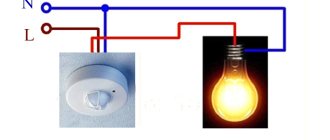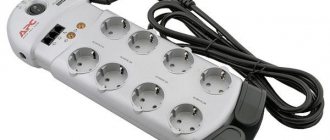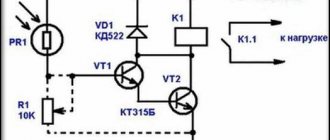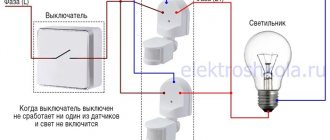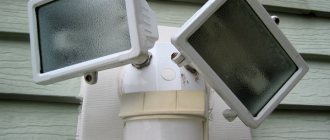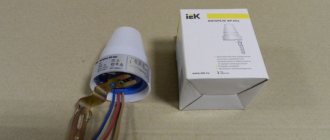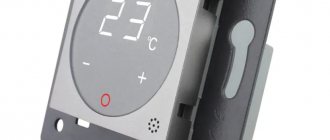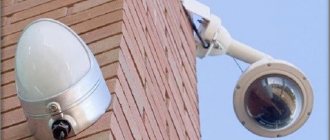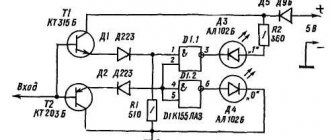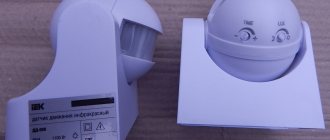Constantly switched on lighting is costly and sometimes even economically unprofitable. For such purposes, special motion sensors are installed. They are built into the power supply circuit of the lamps. In the “normal” state, this device breaks the circuit. The appearance of any object in motion in the immediate vicinity of it closes the contacts and turns on the light. This is necessary where people are only occasionally present, and is also very convenient outside buildings. Let's take a closer look at what this invention is and help you decide on a purchase.
Kinds
Motion sensors are divided into:
- Infrared. They react to heat. They are used inside buildings and are safe, however, malfunctions may occur.
- Ultrasonic. They emit waves of 20-60 kHz. The sound is reflected from the object, captured and analyzed by the device. The disadvantages are the low range; if the object moves slowly, it may not react; if you have pets in the house, it is better not to use it. A possible advantage is repelling mosquitoes.
- Acoustic. React to noise. For use in basements only.
- Microwave. An electromagnetic wave with a frequency of about 1 GHz is used. The device is compact in size and can be easily hidden by installation. According to the radius of influence, it covers a large distance, determined by the power of the transmitter and the sensitivity of the receiver. The sensor's operation is almost unaffected by the environment around it. The downside is the high price.
- Combined. The detectors combine infrared and ultrasonic wave spectra.
Next, the sensors are divided according to their location and installation:
- Outside the building. The operating radius ranges from 100 to 500 meters. Usually these are private houses, industrial enterprises and courtyards.
- Inside the building. According to the characteristics, it is selected optimally according to the area of the room. They have a short range of action. They can be located, for example, in entrances, apartments, rooms.
According to the methods of installation and installation of equipment, they are divided into:
- Wall or corner. According to the name, it is attached to the wall or to the ceiling. They have a small viewing angle, therefore, avoiding false alarms of the sensor.
- Ceiling. Mounts on the ceiling, detection angle is 360 degrees. This is very important for rooms where there are several doors.
- Built-in. Miniature models that are installed in an inconspicuous place.
According to the method of supplying electrical energy, there is a division into:
- Wired. They have a very reliable power supply, which ensures uninterrupted and virtually trouble-free operation of the room recorder. The disadvantages are the need to stretch meters of wire and search for a free outlet.
- Autonomous. Power comes from one or more batteries, which are most often located inside the sensor in the housing. Models powered by solar batteries are available. The downside is the constant monitoring of current consumption, which changes its values over time.
Based on the number of contacts they are divided into:
- Two-pin. Used in conjunction with simple lamps connected to a 220V network.
- Three-pin. They are used with different types of lamps, and are also recommended for connecting the coil of a magnetic starter, with the connection of a powerful load.
These are just the main groups into which this type of equipment is divided; there are quite a lot of them.
What types of sensors are there?
Motion detection devices work on the principle of using electromagnetic radiation of different wavelengths. There are exotic capacitive sensors that are triggered by a change in capacitance as a person approaches a target object. They work at a short distance if someone has already reached out to the safe with money. They are used in special tracking systems and are not used for mass consumption.
Sensors of detection devices are divided into active, when the sensor sends waves into the working area and is triggered when the characteristics of the reflected wave change, and passive, which are triggered only when wave radiation from a moving object is detected. Combined devices are also produced that use mainly infrared and microwave radiation simultaneously.
The first include:
- ultrasonic;
- photovoltaic;
- microwave;
- radio waves.
The second include infrared, which register waves of thermal radiation from a person or animal.
Ultrasonic devices, sending high-frequency sound waves, are triggered when the reflected signal from a detected object changes characteristics. This principle is used not only to detect a person, but, for example, when opening a garage door to turn on a light.
Photovoltaics work on the principle of interrupting the light beam. The receiving photo relay in this case sends a signal to the executive body. Very convenient for securing passage through a gate, door or turnstile.
Microwaves and radio waves inherently use the same waves, just at different frequencies. Radio waves are rarely used, since low-frequency radiation may not pass through some obstacles, such as metal walls or doors. Microwaves operate at frequencies above 5 gigahertz, this radiation penetrates any obstacle. All of them are relatively expensive and are used for large commercial premises.
Active sensors for control in the work area are more expensive than passive ones and are used in special conditions for the protection of very large objects. It is irrational to use them for household needs to turn on electricity. This also applies to combined analogues.
Structurally, thermal switching devices are made in various protected designs for indoor and outdoor use. The material for the cases is heat-resistant plastic. They are mounted on walls and ceilings at the height recommended by the manufacturer.
TOP 7 best motion sensors for turning on lights
Here is a rating of the best representatives of sensory equipment.
The TOP 7 includes the following models:
- Orbit 360 degrees CIRCUMAT PRO CR white DU OB134912;
- Brennenstuhl 1170900;
- Feron Sen 30 230V 500W 5-8 cm 30 with white cable 1.5 m 22068;
- TDM DDM-02 SQ0324-0021;
- Camelion LX-28A 6438;
- Rev Ritter "Action" 110;
- EKF PROxima dd-ms-22B.
Orbis 360 degrees CIRCUMAT PRO CR white DU OB134912
Design and principle of operation
Structurally, the motion sensor contains several components that will differ depending on the type.
Rice. 1. Motion sensor device
For example, consider the device of an infrared sensor, which consists of:
- PIR pyroelement, which responds to changes in the physical parameters of the environment;
- field-effect transistor T1, acting as an electronic key;
- shunt resistor R1 connected in parallel to the pyroelectric element.
The principle of operation is the ability of pyromaterial to change its own characteristics depending on the degree of thermal radiation falling on it. The light flux reduces the resistance of the PIR pyroelectric element and a signal comes through it to open the field-effect transistor. In this state, current will flow through the load, which can be a relay coil or other logical element. If a person or other object appears in the area of the sensor, the light flux will be interrupted and will no longer affect the pyroelement, and the automatic system will operate, issuing a corresponding signal about the occurrence of movement.
Comparison of models
For clarity, let’s create a table of the sensors we reviewed with their characteristics.
| Model | Viewing angle, degrees | Range, m | Maximum load power, W | Installation height, m | Dimensions, mm | Weight, g |
| Orbis 360 degrees CIRCUMAT PRO CR white DU OB134912 | 360 | 30 | 2200 | 7 | 140x80x175 | 340 |
| IP44 Brennenstuhl 1170900(180 degrees) | 180 | 12 | 1000 | 7 | 100x150x75 | 220 |
| Feron Sen 30 230V 500W 5-8 cm 30 with white cable 1.5 m 22068 | 30 | 0,08 | 500 | — | 79x35x19 | 61 |
| TDM DDM-02 SQ0324-0021 | 180 | 8 | 1200 | 3,5 | 86.4x60.4x98 | 180 |
| Camelion LX-28A 6438 | 360 | 6 | 1200 | 2,5 | 120x65x120 | 149 |
| Rev Ritter "Action" 110 | 110 | 12 | 1000 | 2,5 | 120x65x120 | 185 |
| EKF PROxima dd-ms-22B | 360 | 6 | 2000 | 4 | 115x25x115 | 110 |
Results
Home touch sensors will allow you to significantly save on lighting. The device will turn on the light in the hallway, kitchen, bathroom, on the threshold of the house when a person appears and turn it off if there is no movement.
Modern sensors can be configured so that they do not react to pets
The cost of the simplest sensors starts from 400 rubles. You can install such sensors yourself. It is better to entrust the installation of more complex and expensive devices to professionals.
How does it work
Most devices use infrared radiation technology, because human thermal energy is in this range. An important element of the motion indicator is an optical system that reacts to the presence and change of thermal radiation in the infrared range and sends an electrical signal. The auxiliary devices then turn the lights on and off.
Main varieties
There are several types of sensors that respond to the movement of an object. They work on different technical principles, but perform the same task. When detecting a moving object, the electronic circuit of the device includes a relay, to the contacts of which any external device can be connected.
The following types of motion detectors exist:
- Infrared sensor;
- Ultrasonic sensor;
- Radio wave sensor.
The infrared sensor uses a PIR sensor that responds to the thermal radiation of an object. Sensors of this type are low cost, reliable and are used both in security systems and to control lighting and other household appliances.
Ultrasonic sensors emit a signal at a frequency above 30 kHz and work as an acoustic locator. Sensors operating on this principle have a limited range due to signal attenuation, and their operation also disturbs pets. Among other things, they cannot be used outdoors due to the large number of moving objects.
Radio wave sensors also work like a locator, but instead of sound waves they emit microwave microwaves. Microwave radiation is unsafe for humans and the cost of radio wave sensors is slightly higher than that of other systems.
For use at particularly important objects, combined sensors are used, including an infrared detector and a radio wave sensor, located in a common housing and operating in parallel.
In home security alarms and for controlling electrical appliances, infrared sensors are most widely used. They have a wide capture area, good range and are absolutely safe for humans.
There are innovative promising developments using semiconductor lasers, but so far such devices are expensive and have a limited scope of application.
Connection diagram
There are several schemes:
- sequential;
- parallel;
- for several sensors;
- using a magnetic starter.
In the first case, control is transferred entirely to the sensor.
If it is necessary to turn on the light for a long time and the object will not be in the coverage area, a switch is placed parallel to the sensor. When repairing a car and being under it, a person will need lighting, but his movements will not be detected. Then, upon completion of the work, it will be necessary to manually turn off the light with the switch, but it will turn on again thanks to the sensor and turn off when the object leaves the radius of the device.
In spacious rooms you need several pieces, connected in parallel and from one phase.
A magnetic starter is used when using powerful lamps or additional electrical equipment.
Design
Sensors come in different types (see Figure 1): some are designed for ceiling mounting, others for wall mounting. This does not mean that each type of device must be installed strictly on the ceiling or walls: it all depends on the configuration of the room and the task at hand, which may be extraordinary. However, in most cases the design is optimally adapted to the appropriate placement. You should also pay attention to the recommended range of possible installation heights.
Rice. 1. Wall-mounted infrared sensor with horizontal rotation
Rice. 1. Wall-mounted infrared sensor with vertical rotation
Rice. 1. Microwave sensor for installation in a suspended or suspended ceiling
Tips for choosing
Experts advise taking into account the following features:
- Place. On the street it is better to choose an IP protection level of at least 55, under a canopy 44. At home you can take less.
- Obstacles. In apartments, private houses and in the countryside, we recommend choosing IR sensors or combined IR + ultrasonic ones. For security purposes, garages, and warehouses, microwave models that respond even through partitions are ideal.
- Corner. Where there are 2 or more doors, a 360 degree sensor is suitable. In other cases, it is possible to take it 180 degrees.
- Power of lamps. We look and choose with reserve.
- Radius. At home, the minimum values are enough; street lighting requires precise calculations.
- Availability of photo relay. In order to save more energy, the sensors are equipped with special light detectors.
- Pet protection. We choose a model with protection against them.
We hope you find this article helpful. We wish you success!
Settings
Once the sensor has been selected and installed, it must be configured. For infrared sensors, as a rule, three parameters can be adjusted: illumination level, sensitivity and shutdown time.
- Illumination level (LUX) is the threshold illumination measured in lux at which the sensor starts or stops triggering. This is necessary to ensure that the light does not turn on during the daytime. Sometimes, for convenience, the sensor’s passport indicates the illumination range: from the minimum value (for example, 3 lux) to daylight.
It is not difficult to select a comfortable threshold value manually. To do this, you need to wait for the level of illumination at which you need to turn on the light, and, by rotating the regulator, find the corresponding position on the scale.
- The sensitivity (SENS) of the sensor determines the range at which it detects moving objects. It is worth considering that the sensor has the greatest sensitivity when a moving object moves perpendicular to the rays of the detection zone, and the least when moving parallel to the rays (see Figure 3).
Figure 3
- The switch-off time (TIME) is the time after which the light will automatically turn off after stopping movement in the sensor's viewing area.
